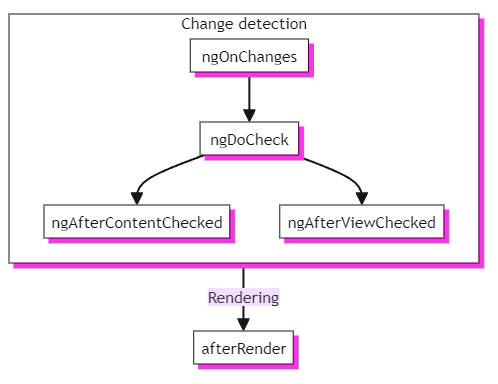Angular afterRender (afterEveryRender) & afterNextRender NEW phases API
Angular provides powerful lifecycle hooks for component interaction, but sometimes you need to work directly with the DOM after rendering. This is where afterRender and afterNextRender come in handy.
Understanding the Need
Imagine you want to integrate a third-party charting library that relies on DOM elements for visualisation. Standard lifecycle hooks might not be ideal for this scenario, as the library might require the DOM to be fully in place before initialisation. This is where afterRender and afterNextRender provide a solution.
Key Differences
While both hooks deal with post-rendering tasks, there's a crucial distinction:
afterRender allows you to register a callback that executes after every render cycle. It is stable in Angular 20 and has been renamed afterEveryRender.
afterNextRender: registers a callback that executes ONLY ONCE after the next render cycle, when the DOM is loaded.
Choosing the Right Hook
Use
afterNextRenderfor one-time DOM manipulations like initializing third-party libraries or setting up element observers.Use
afterRenderfor scenarios where you need to react to frequent DOM changes, like dynamically adjusting element sizes based on content.
Remember: frequent use of afterRender can impact performance, so use it judiciously. And they both must be used inside an injection context. These hooks don’t work on SSR or pre-rendering.
Order of Phases
Angular defines distinct phases for controlled DOM access during rendering:
EarlyRead: allows data from the DOM to be read before subsequent write operations.
Write: Allows data to be written to the DOM (avoid reading during this phase).
MixedReadWrite: permits both reading and writing, but use it cautiously due to potential performance drawbacks.
Read: allows reading data from the DOM (avoid writing during this phase).
Callback Execution Order ➡️
Callbacks within the same phase execute in the order they are registered.
Callbacks run after each render cycle, following this specific phase order:
earlyReadwritemixedReadWriteread
During initialization (from angular.dev)
Subsequent updates (from angular.dev)
Parameter Passing Between Phases
The first phase callback (earlyRead) receives no parameters.
Each subsequent phase callback receives the return value of the previously run phase callback as a parameter. This enables coordination of work across multiple phases.
Profitable Examples
Here are some practical use cases for these hooks:
Initializing Third-Party Libraries: use
afterNextRenderto ensure the DOM is ready before initializing libraries like Chart.js.Setting Up Element Observers: utilize
afterNextRenderto set up IntersectionObserver or ResizeObserver, as these APIs rely on the element's presence in the DOM.Dynamic Content Sizing: implement
afterRenderwith theReadphase to adjust element dimensions based on dynamically loaded content.Detaching Temporary Elements : use
afterNextRenderto remove temporary elements you added during the rendering process (like cleaning up after a modal is closed ❌).
Important Considerations x
afterRenderandafterNextRenderare for browser-specific operations and won't work during server-side rendering.Consider using built-in Angular functionalities like
ngAfterViewInitfor component initialization tasks, whenever possible.While
afterRenderallows reading the DOM, be cautious due to potential hydration mismatches between server and client rendering.They can only be declared in injection context.
By understanding these concepts, you can leverage afterRender and afterNextRender effectively to create a seamless interaction between your Angular applications and the DOM.
Custom Inject Function
You can encapsulate OnInit login into a custom inject function. Thank you Chau Tran for this.
You can play with this code, which is explained in this video:
Thanks for reading so far 🙏
I’d like to have your feedback, so please leave a comment, clap or follow. 👏
Spread the Angular love! 💜
If you liked it, share it among your community, tech bros and whoever you want! 🚀👥
Don't forget to follow me and stay updated: 📱
Thanks for being part of this Angular journey! 👋😁







